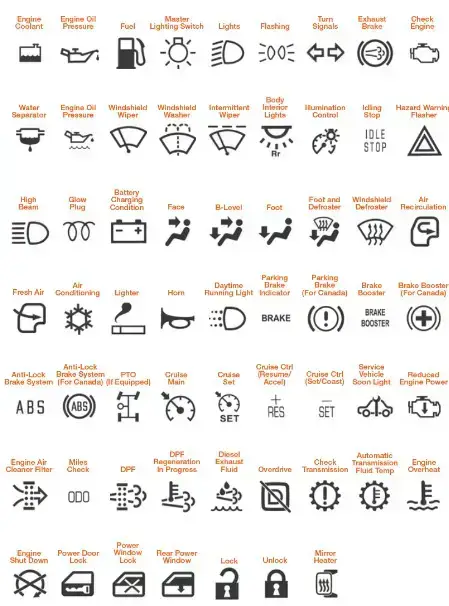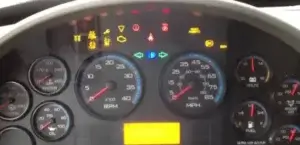International Truck Warning Symbols

Did you know that around 30% of drivers acknowledge that they ignore dashboard warning lights? Less than half of drivers admit to fully understanding the meanings of these symbols.
The dashboards in modern trucks are equipped with symbols that alert drivers about potential issues or significant changes they need to address. Understanding these International Truck Warning Symbols is essential for keeping everyone safe on the road and ensuring the truck stays in good shape.
Even though these symbols are similar in most trucks, they are different depending on the make and model of your truck. Check your manual to confirm the exact warning signs and its meaning.
In this guide, you’ll learn about top signs you should know, including triangle warning signs, symbols with wrenches, and brake warning signs, among others, and what some of them mean.
What Do The Symbol Colors Mean?
Red:
These warning symbols represent critical or severe issues that require immediate attention. They signal serious problems such as engine overheating, low oil pressure, or brake system failure. Ignoring red light symbols can pose significant risks to your safety and the vehicle’s health. When a red warning light appears, it’s essential to pull over safely and address the problem promptly.
Yellow:
Yellow or amber warning symbols signify problems that need attention but might not be as urgent as red symbols. These indicators often highlight issues such as a faulty engine, low fuel, or a problem with the emissions control system. While not immediate emergencies, yellow symbols should not be ignored. Having these issues checked by your mechanic at your earliest convenience can prevent potential breakdowns or engine shutdowns.
Green:
These symbols are usually informational or confirmatory. They typically represent non-critical notifications such as turn signals being on, lights being engaged, or other systems being active. While they don’t indicate a problem, paying attention to these symbols for information about your truck’s various functions and operations is essential.
Blue:
These symbols indicate that a specific system is engaged or functioning. Commonly, they represent signals like high-beam headlights being on or the coolant temperature being at a normal level. Like green symbols, blue warnings are generally informative and signify the status of certain systems in your truck.
Some of The Most Important Lights Explained
Check Engine Light (CEL)
The CEL, depicted as an engine-shaped icon, is one of the most crucial warning symbols. It signals issues related to the engine or its components. When illuminated, it produces a fault code to indicate various problems, from a loose gas cap to more severe issues like engine failure or a malfunctioning catalytic converter.
While the Check Engine Warning Light may not always imply an urgent problem, it’s advisable to have it checked by a mechanic as soon as possible to prevent potential damage to the engine and ensure optimal performance.
Battery Service Light
Often resembling a battery-shaped icon, this light warns about potential problems with the charging system or the battery itself. When this light comes on, it could indicate a failing battery, a faulty alternator, or issues with the electrical system. Ignoring this warning may result in a drained battery, leading to your truck stalling or being unable to start. Addressing battery-related issues promptly is essential to avoid being stranded unexpectedly.
Temperature Light
This light resembles a thermometer or a thermometer inside a droplet. It indicates that the engine is overheating. This warning could indicate low coolant levels, a malfunctioning cooling fan, or a faulty thermostat. Ignoring this warning may cause severe engine damage due to overheating. It’s crucial to pull over safely if this light comes on, turn off the engine, and allow it to cool down. Refill the coolant if necessary, and seek assistance from a mechanic to diagnose and fix the underlying issue.
ABS Warning Light

The Anti-lock Braking System (ABS) warning light appears as “ABS” inside a circle or as the letters “ABS.” It signals issues with the ABS, designed to prevent wheel lock-up during sudden braking, especially on slippery surfaces. It indicates a malfunction in the ABS, potentially compromising your vehicle’s braking capability. While the conventional braking system should still function, it’s crucial to have it checked to ensure optimal safety.
Fuel Level Light
Often depicted as a fuel pump icon, it indicates low fuel levels in your tank. When this light comes on, it’s a reminder to refuel your truck promptly. Running out of fuel while driving can leave you stranded and cause damage to the fuel system. Keeping an eye on this warning light and refilling your tank when low is crucial for preventing unexpected breakdowns and ensuring uninterrupted travel.
You can use cruise control, especially on flat roads. However, in areas with varying terrain, using cruise control might increase fuel consumption. Stay attentive to speed limits and surrounding traffic.
Brake Warning Light
This is often depicted as an exclamation mark inside a circle or the word “BRAKE.” It indicates potential issues with the braking system. It may suggest problems such as low brake fluid levels, worn brake pads, the parking brake still being on, or a malfunction in the brake system. Ignoring this warning could compromise your vehicle’s braking ability, leading to unsafe driving conditions. It’s crucial to have it inspected immediately by a qualified mechanic to address any underlying issues.
Coolant Warning Light
This resembles a thermometer or a jug pouring liquid. It indicates issues with the engine’s coolant system. It could mean low coolant levels, a coolant leak, or a malfunction in the cooling system. Ignoring this warning could lead to engine overheating, which may cause severe damage. If this light comes on, pull over safely, allow the engine to cool, and check coolant levels. Seek professional assistance to diagnose and rectify the problem.
Oil Can Indicator Light
Often resembling an oil can or an oil droplet, it signals potential issues with the engine’s oil level or pressure. It may indicate low oil levels, oil degradation, or problems with the oil pump. Ignoring this warning could lead to significant engine damage due to inadequate lubrication. If this light appears, immediately check the oil level using the dipstick and add oil if necessary. If the light persists, seek prompt, professional assistance to prevent engine damage.
Service Vehicle Soon Light
Appearing as “SERVICE VEHICLE SOON” or an engine icon with the word “SERVICE” is a general warning indicating that a vehicle system needs attention or routine maintenance is due. It may suggest several issues that require inspection, such as problems with the engine, transmission, or emissions systems. While not an immediate emergency, don’t overlook this warning. Schedule a visit to a certified mechanic or service center to diagnose any potential problems indicated by this light.
Tire Pressure Warning Light
This light resembles an exclamation mark inside a tire shape or the letters “TPMS” (Tire Pressure Monitoring System), which alerts you to potential tire pressure issues. The light may indicate low tire pressure on one or more tires. Driving with insufficient tire pressure can compromise truck handling, fuel efficiency, and tire lifespan. If this light appears, check the tire air pressure using a gauge and inflate the tires to the recommended levels.
DPF (Diesel Particulate Filter) Light
The DPF warning light, often depicted as an exhaust pipe icon, signals potential issues with the exhaust system or DPF. This filter is designed to trap and reduce harmful emissions from the exhaust, specifically capturing soot particles. When this light comes on, it indicates a blockage or high soot accumulation within the filter.
Driving with a blocked or highly saturated DPF can lead to decreased engine performance, increased fuel consumption, or even potential damage to the filter and the engine.
A DPF flashing light accompanied by a beeping alarm indicates that the exhaust filter is entirely full, leading to a partial limitation in engine power to prevent potential damage.
Driving at higher speeds for an extended period, especially on highways, might aid in regenerating the filter by burning off trapped soot. However, if the light remains on or the regeneration process fails, seeking professional assistance from a certified mechanic or service center is crucial.
High Exhaust System Temperature (HEST)
The HEST warning light is a crucial indicator that alerts drivers to excessive temperatures in a truck’s exhaust system, typically found in diesel engines equipped with an after-treatment system. Often depicted as an exhaust pipe or thermometer icon, this warning light comes on when the exhaust system’s temperature surpasses the normal operational range.
FAQs About Engine Lights
What are hazard vehicle warning lights?
These indicators on your dashboard alert you to potential issues or problems with your semi-truck systems. These warn engine lights come in various forms, colors, and symbols, each representing different aspects of your vehicle’s health. They can range from lights indicating low fuel levels, tire pressure concerns, engine malfunctions, or problems with braking systems. Hazard warning lights serve as cautionary signals, prompting drivers to take action or seek professional assistance to address underlying issues promptly.
What is the most serious warning light in a car?
While all warning lights demand attention, the most serious warning light in a car is often the Check Engine Light (CEL) or Engine Malfunction Indicator Lamp (MIL). This light means there could be potential issues within the engine or its related systems. Ignoring this warning can lead to severe damage, affecting your truck’s performance and possibly causing costly repairs. It’s crucial to promptly address the warning light by consulting a mechanic or technician to diagnose and prevent further complications.
Can I still drive with a warning light?
The response to whether it’s safe to drive with a warning light illuminated on your dashboard depends on the specific light and its severity. Some warning lights, like those indicating low fuel, may not require immediate action and allow for continued driving.
However, certain warning lights, especially those indicating critical issues like engine overheating, low oil pressure, or brake system failure, demand immediate attention.
It’s crucial to refer to your owner’s manual to understand the implications of each warning depending on the model of your truck, whether it’s Ford, Toyota, Navistar, or Freightliner, and whether it’s a line of heavy-duty trucks like the International ProStar MaxxForce.
As a general rule of thumb, if a warning light appears that could compromise your safety or cause significant damage to the truck, it’s best to pull over, turn off the engine, and seek technical assistance before continuing your trip.
What is the engine malfunction symbol?
The engine malfunction symbol, also known as the Check Engine Light (CEL), is represented by an engine icon. It can indicate various problems, including engine misfires, emission control engine malfunctions, or issues with sensors and components. When this dash light appears, have it checked by a mechanic.
Can the engine light come on for low oil?
The CEL can illuminate due to low engine oil levels or oil-related problems. While the CEL primarily indicates issues related to the engine’s various systems, it may be triggered by low oil pressure or insufficient oil levels in the engine. Low oil levels can lead to inadequate lubrication, potentially causing engine damage or increased friction between moving parts. So, it’s advisable to check the engine oil level using the dipstick and add oil if necessary.
What light comes on for transmission problems?
For transmission problems, the Transmission Warning Light or Transmission Temperature Light is the indicator that alerts drivers to potential issues within the transmission system. The warning light may appear as “TRANS,” “O/D,” or resemble a gear symbol. It can signal various transmission-related problems, such as overheating, fluid leaks, or electronic control system malfunctions. It’s crucial to address it promptly by checking transmission fluid levels and consulting a qualified technician.
Need a Maintenance Solution?
Understanding and addressing dashboard warning signs is crucial for safe and efficient operations. At Kyrish Truck Center Group, we understand the significance of proactive maintenance in ensuring the longevity and safety of your fleet.
Our team specializes in deciphering these warning symbols, providing comprehensive insights, and offering maintenance solutions tailored to your truck’s needs.
Don’t wait for breakdowns! Contact us today and enjoy the advantages of proactive, reliable maintenance to keep your trucks running smoothly.

